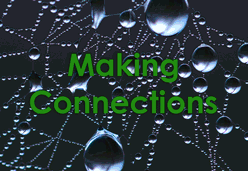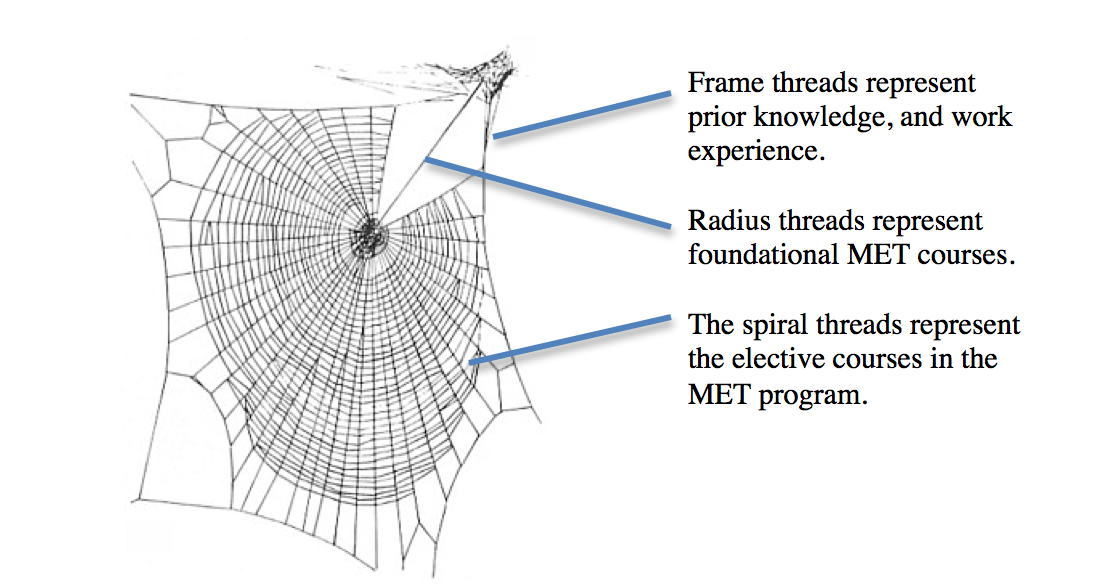 Welcome to my e-portfolio. I create this as the capstone project for the ETEC590: Graduating Project course, my final course in the University of British Columbia’s (UBC) Master of Educational Technology (MET) program.
Welcome to my e-portfolio. I create this as the capstone project for the ETEC590: Graduating Project course, my final course in the University of British Columbia’s (UBC) Master of Educational Technology (MET) program.
The Web
When a spider builds a web, it first creates a framework for the web structure to hang from. Then radius threads are added. These provide the structure. And finally, the spider will add the spiral threads. The following graphic shows the metaphor within the content of my learning:
The web metaphor illustrates how the knowledge from the MET courses intersect at many points. As I reflect on my experience in the MET program, the connections between the courses, my previous knowledge and experiences stood out for me. As a whole the spider’s web metaphor works to show learning connections; connections that are made at a neurological level, connections to learners (past, present and future) knowledge, and to instructors in the MET program, as well as the broader ed tech community through the Web 2.0 connections facilitated by the Internet. For those reasons a spider web metaphor seemed that it would fit with my learning experiences.
I noticed there are some key topics that intersect in many of the courses. For example, things like media literacy, affordances of educational technology, and learning theories come up in many of the core and non-core courses. An online e-portfolio works well to showcase the interconnections, and connections to other outside knowledge. Labissiere and Reynolds discuss “ hyperlinking, which is the primary activity of building a website, forces students to make new connections with what has previous been learned” and that such practices, “encourage metacognitive skills development”(2004).
Artifacts and Reflections
This e-portfolio site and artifacts selection is for the ETEC590: Graduating Project. Working through the ETEC590: Graduating Project course has provided me an opportunity to reflect on the entire MET program, rather than just individual courses or assignments alone. The reflections and artifact selection process for my e-portfolio have been purposeful and systematic. Artifacts selected from the foundational MET core courses reflect key theories, concepts and ideas about education and educational technology and fall on the radius threads of the web. Artifacts falling on the spiral threads are from the elective MET courses. And often the artifacts will fall where the spiral and radius, or frame threads intersect. I discuss these intersections in my reflections.
Guided Tour
I’ve designed this e-portfolio site so that it contains all the information and components required for the capstone project. The site design permits users to access the artifacts from multiple locations:
- The course artifacts and all the components for the ETEC590: Graduating Project have been organized within the “spider web” metaphor, and can be accessed from the top course menu.
- The right navigation menu is organized by the course codes. The course artifacts are accessible from that menu. I’ve listed the courses in the sequence that I took the courses, with the earliest course on the top.
- One of my personal goals is to continuously explore technologies, and ways of implementing them for education. I used StoryMap JS, an online authoring tool used in journalism, to create an interactive Web of Learning online multimedia interactive graphic of the selected artifacts and related reflections. This multimedia artifact can be accessed from the ETEC590 link in either of the previously mentioned menus.
To avoid getting “tangled” in the web, here is a quick tour of this e-portfolio site.
MET Program Timeline
I created this interactive timeline, using Timeline JS, to show how I progressed through the MET program.
References
Labissiere, Y. & Reynolds, C. (Fall, 2004). Using electronic portfolios as a pedagogical practice to enhance student learning. Inventio 7(2). Retrieved from: http://web.archive.org/web/20120108155509/http://www.uiowa.edu/~outcomes/documents/Labissiere.pdf
Credits
Site Background image: “details of a web” (CC BY-ND 2.0) by Cast a Line
Banner image: “In the spider’s web…” (CC BY 2.0) by vauvau
